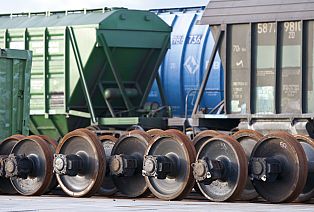Analytics, Cargo, Estonia, Transport
International Internet Magazine. Baltic States news & analytics
Friday, 02.01.2026, 19:27
In 2014, the carriage of passengers and goods declined in Estonia
 Print version
Print version |
|---|
In 2014, the number of passengers carried by Estonian transport enterprises amounted to 211 million. 92.7% of these passengers were carried by road, 4.1% by sea, 2.8% by rail and 0.4% by air.
3% fewer passengers used road transport, compared to 2013. There were 195.6 million passengers in total and 85% of them, i.e. about 167 million passengers, used urban transport (i.e. buses, trams and trolleybuses). The number of passengers using county lines was about 17 million (up by 2% compared to 2013). National non-scheduled transport was used by 5 million passengers (up by one third). The number of passengers was 4.4 million on domestic highway lines (down by 2%) and 808,700 on international lines (up by 10%). In 2014, the passenger traffic volume of road transport enterprises decreased by 2% and was 2.6 billion passenger-kilometres.
In 2014, Estonian sea transport enterprises carried 8.7 million passengers, which is 1% less than in 2013. The number of passengers carried was 2.2 million in domestic sea traffic (up by 4%) and 6.5 million in international sea traffic (down by 3%). The passenger traffic volume of sea transport enterprises decreased by 4% and was nearly 1.2 billion passenger-kilometres in 2014.
Last year, with the arrival of new trains, the number of passengers using rail transport increased significantly. Around 5.9 million passengers were carried by rail, which is 41% more than in 2013. 5.8 million passengers were carried in domestic rail traffic (up by 43%) and 97,100 passengers were carried in international rail traffic (down by a fifth compared to 2013). The passenger traffic volume of rail transport enterprises increased by 26% and was 281.7 million passenger-kilometres.
In 2014, Estonian air transport enterprises carried 771,300 passengers. This is 1% more than in 2013. 17,800 passengers were carried in domestic air traffic (down by 7%) and 753,500 passengers were carried in international air traffic (up by 2%). The passenger traffic volume of air transport enterprises increased by 29% and was 1.4 billion passenger-kilometres in 2014. Scheduled passenger air transport decreased, but the increase in passenger turnover was due to the growth in charter flights.
In 2014, 75.1 million tonnes of goods were carried by Estonian transport enterprises, of which nearly 50% was carried by road, 48% by rail and 2% by sea.
Despite the overall decrease in goods transport volumes, road transport companies carried nearly 37.2 million tonnes of goods in 2014, which is 12% more than in 2013. 23.6 million tonnes of goods were transported in domestic road traffic and 13.6 million tonnes in international traffic. Freight turnover increased by 7% compared to 2013 and totalled 6.9 billion tonne-kilometres. There was a growth both in domestic transport and in international transport.
In 2014, the amount of goods carried by rail was nearly a fifth smaller than the year before, amounting to 36.3 million tonnes. The year-over-year decrease in freight volume in 2014 was the largest since 2007 and 2008. 20.1 million tonnes of goods were transported in domestic rail traffic and 16.2 million tonnes in international traffic. Freight turnover decreased by a third compared to 2013 and amounted to 3.3 billion tonne-kilometres.
Estonian sea transport enterprises carried 1.6 million tonnes of goods in 2014, which is 17% less than in 2013. The freight turnover in sea transport decreased by more than a half compared to 2013 and amounted to 425 million tonne-kilometres.
Estonian air transport enterprises carried 3,000 tonnes of cargo and the freight turnover was 1.8 million tonne-kilometres in 2014. Compared to 2013, there was 50% more cargo transported and freight turnover increased by 19%. Among the cargo transported by air, the carriage of postal shipments increased.
Carriage of passengers and goods by transport enterprises, 2014
|
|
Passengers, millions |
Passenger traffic volume, billion pkm |
Freight, million tonnes |
Freight turnover, billion tkm |
|
Total |
211.0 |
5.5 |
75.1 |
10.6 |
|
Road transport |
195.6 |
2.6 |
37.2 |
6.9 |
|
..urban transport |
167.0 |
0.8 |
- |
- |
|
Rail transport |
5.9 |
0.3 |
36.3 |
3.3 |
|
Sea transport |
8.7 |
1.2 |
1.6 |
0.4 |
|
Air transport |
0.8 |
1.4 |
0 |
0 |
- magnitude nil
The data of Estonian transport enterprises are collected and published according to the enterprise’s principal activity. The enterprise’s principal activity is determined based on the Estonian Classification of Economic Activities (EMTAK (NACE)): land transport (rail and road), water transport and air transport.
Passenger traffic volume is the volume of work done in the transport of passengers. It is measured in passenger-kilometres (pkm). One passenger-kilometre is the transport of one person across a distance of one kilometre.
Freight turnover is the volume of work done in the transport of goods. It is measured in tonne-kilometres (tkm). One tonne-kilometre is the transport of one tonne of goods across a distance of one kilometre.








 «The Baltic Course» Is Sold and Stays in Business!
«The Baltic Course» Is Sold and Stays in Business!

